The 1080 gets embedded
Analytical chemistry goes Fourier in 1972
Analytical chemists want to know how molecules are put together. There are many tools available to do this, but nuclear magnetic resonance (NMR) spectroscopy, mass spectroscopy (MS) and infrared (IR) spectroscopy are the major tools. Fourier versions of all three became practical realities around 1972. The new Fourier instruments had greatly increased sensitivity and resolving power. Nicolet's 20 bit computer was well positioned. The Fourier instruments pushed technological limits, but there were clear business opportunities. Nicolet started a division called Nicolet Instruments in response.
Fourier Transform Nuclear Magnetic Resonance (NMR) Spectroscopy
A version of the 1080, called the BNC-12, was developed and sold to Bruker for their NMR spectrometers. In this connection I made several trips to see Bruker in Germany and Switzerland. Bruker was a very good OEM customer. That is where I met Tony Keller. Varian, of Palo Alto, California was and still is a major NMR company. As far as I know, Varian never directly purchased a Nicolet computer. Nevertheless, according to ex Varian emplyees, Varian used a Nicolet 1080 for internal NMR development. One of Nicolet's customers must have been a stool pigeon. Later, Varian developed a 16 bit computer, the 620, which was not very successful.
Japan Electron Optics Laboratory (JEOL) was and is a significant NMR company. JEOL did buy Nicolet computers.
Nicolet launched Nicolet Technology in 1972 in Mountain View—right in Varian's backyard. The NT-150 was Nicolet Technology's first FTNMR. It was aimed squarely at both Varian and Bruker. The NT-150 probably prompted Bruker's decision to develop their own computer. During one of my Bruker visits I saw circuit diagrams on a drafting table I instantly recognized as my own. It was no surprise when Bruker introduced the Aspect 2000. It was very similar to the 1080, but it had 24 bits.
Nicolet Technology NT-150 NMR Spectrometer
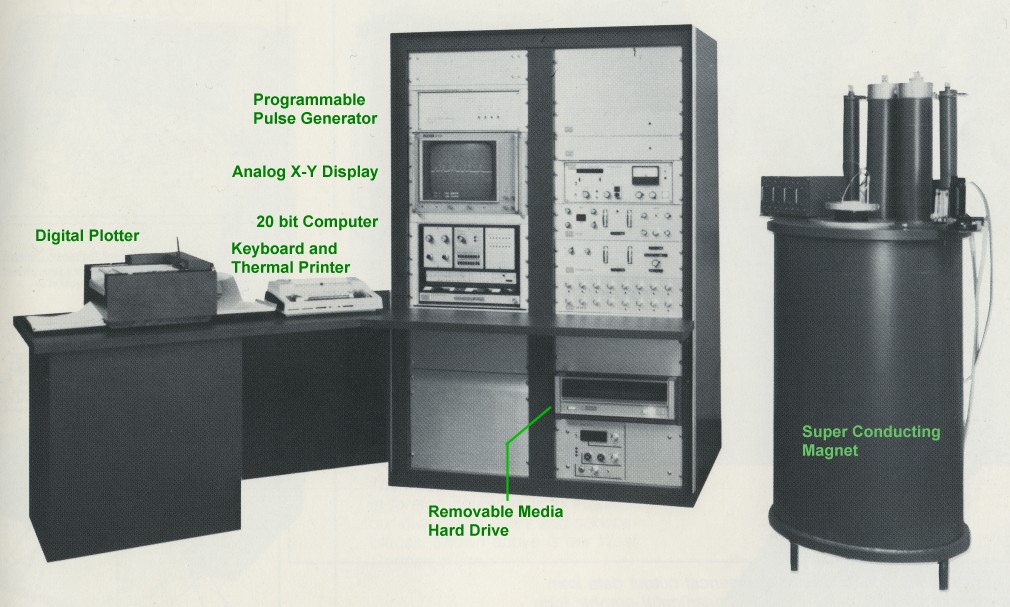
The NT-150 was state of the art. It had a liquid helium cooled superconducting magnet. It used an ultra stable frequency synthesizer to achieve multinuclear capabilities. It had no phase locked loops. It had a pulse programmer to make the precisely shaped and timed radio frequency pulse sequences needed for 2 dimensional FTNMR. It had an 1180 which was twice as fast as the old 1080. The Diablo model 30 hard drive had removable media about the size and weight of a very large pizza box. It had almost the speed and the capacity of a 3.5 inch diskette. The noisy 10 character per second teletype was replaced by a blessedly silent 30 character per second thermal printer.
Fourier Transform Mass Spectroscopy (FTMS) AKA
Fourier Transform Ion Cyclotron Resonance Mass Spectroscopy (FT-ICR)
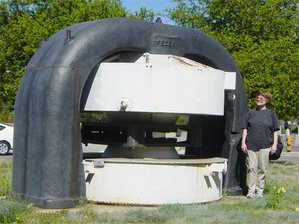 The invention of FT-ICR mass spectroscopy is credited to Alan Marshall and
Melvin Comisarow at the University of British Columbia. The paper describing it first
appeared in the Chemical Physics Letters in 1974. They used the Nicolet 20 bit computer
for data acquisition and fourier analysis. Alan Marshall published an account of how they
did it in the Encyclopedia of Nuclear Magnetic Resonance. (ISBN 0471 95839 5) It starts on
page 486 of the volume is entitled "Historical Perspective." Alan Marshall is now the
director of the NSF National
High-Field FT-ICR Mass Spectrometry Facility. The ICR program is the largest of its
kind in the the world.
The invention of FT-ICR mass spectroscopy is credited to Alan Marshall and
Melvin Comisarow at the University of British Columbia. The paper describing it first
appeared in the Chemical Physics Letters in 1974. They used the Nicolet 20 bit computer
for data acquisition and fourier analysis. Alan Marshall published an account of how they
did it in the Encyclopedia of Nuclear Magnetic Resonance. (ISBN 0471 95839 5) It starts on
page 486 of the volume is entitled "Historical Perspective." Alan Marshall is now the
director of the NSF National
High-Field FT-ICR Mass Spectrometry Facility. The ICR program is the largest of its
kind in the the world.
The invention of the cyclotron in 1936 is credited to E. O. Lawrence—who also lent
his name to the Lawrence Livermore National Lab. Here is a picture of the original. The
cyclotron was a particle accelerator or an atom smasher. Comisarow and Marshal repurposed
it into a mass spectrometer.
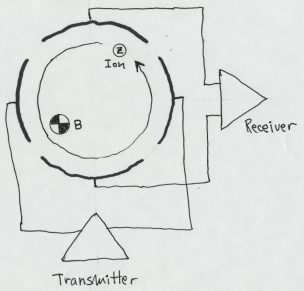 This drawing explains how it works. There is a magnetic field perpendicular to the page
which traps ions by forcing them to move in circles. The "aha" moment comes when you
realize that the time to go around the circle does not depend on the size of the circle.
It depends only on the charge to mass ratio (ignoring relativity). The transmitter is used
to set the ions spinning in circles. The receiver is used to detect the moving ions. The
signal from the receiver yields a mass spectrum after applying the Fourier transform.
This drawing explains how it works. There is a magnetic field perpendicular to the page
which traps ions by forcing them to move in circles. The "aha" moment comes when you
realize that the time to go around the circle does not depend on the size of the circle.
It depends only on the charge to mass ratio (ignoring relativity). The transmitter is used
to set the ions spinning in circles. The receiver is used to detect the moving ions. The
signal from the receiver yields a mass spectrum after applying the Fourier transform.
FT-ICR is sensitive: 100 ions produce a detectable signal. FT-ICR has high resolution: the
charge to mass ratio is measured to one part per million. A single mass measurement is
often sufficient to identify all the atoms in a molecule. Multiple measurements give clues
about their arrangement.
The Nicolet FTMS-1000 Fourier Transform Mass Spectrometer
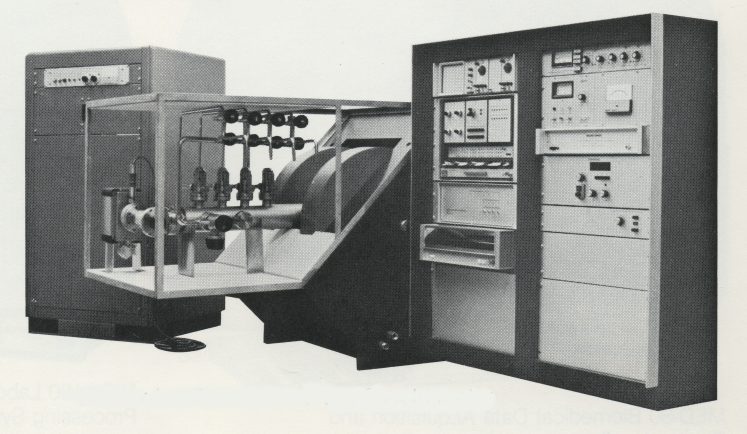
The fast Fourier transform made the FT-ICR Mass Spectrometer possible. Nicolet management
recognized the opportunity. They bought the patent rights and manufacturing rights to a
FT-ICR Mass Spectrometer. Nicolet's first product, FTMS-1000, was introduced in 1976. It
had an iron magnet. The FTMS-2000 came later. It had a superconducting magnet.
The FTMS-1000 and the NT-150 data systems are strikingly similar. Even the programmable
pulse generators are the same. Both machines required homogeneous superconducting magnets.
There should have been synergy, yet the FT-ICR Mass Spectrometer was not a particular
success for Nicolet. Nicolet lost interest in it and shut it down in 1988. The pieces were
purchased by Extrel, which still exists. The FTMS
group was reassembled and operations resumed in a facility a few miles away from Nicolet.
Extrel continued to use the Nicolet 1280 computer. A key component, the SWIFT board,
plugged into the 1280 motherboard. By that time Bruker Instruments had developed and
marketed an FT-ICR too. Bruker and Extrel FTMS were direct competitors. Animosities
developed and there were lawsuits. Extrel hoped to collect damages. There were trials in
federal court in 1991 and 1992. You can read more about it here. Extrel FTMS was
out of business in 1993. Bruker bought the pieces.
Fourier Transform Infrared Spectroscopy
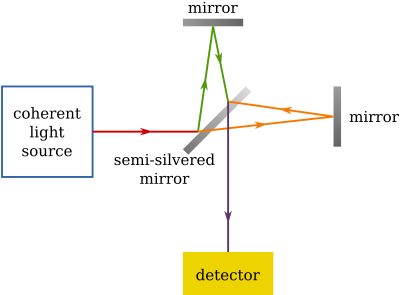 Way back, in 1881, Michelson and Morley did an experiment
intended to measure the absolute speed of the Earth as it moved through the aether. They
used a clever device that has come to be known as the Michelson interferometer. The
experimental result, zero, befuddled them and they never really accepted it. The
befuddlement continued even after Einstein explained what was going on. Their names live
on because the Michelson interferometer can be repurposed into an elegant infrared
spectrometer. The idea had lain dormant until a certain problem was solved. You need to
perform a Fourier transform to use a Michelson interferometer as a spectrometer. The fast
Fourier transform and the digital computer made the Michelson FTIR spectrometer
possible.
Way back, in 1881, Michelson and Morley did an experiment
intended to measure the absolute speed of the Earth as it moved through the aether. They
used a clever device that has come to be known as the Michelson interferometer. The
experimental result, zero, befuddled them and they never really accepted it. The
befuddlement continued even after Einstein explained what was going on. Their names live
on because the Michelson interferometer can be repurposed into an elegant infrared
spectrometer. The idea had lain dormant until a certain problem was solved. You need to
perform a Fourier transform to use a Michelson interferometer as a spectrometer. The fast
Fourier transform and the digital computer made the Michelson FTIR spectrometer
possible.
The Digilab FTS-14 was the first real Michelson FTIR. At first, the FTS-14 used the
Nicolet 1070 signal averager interfaced to a PDP-8 with Nicolet FFT software. Later, the
FTS-14 used a Nicolet 1080. Later still, the FTS-14 used a Data General 16 bit computer
which was very slow but much cheaper. Digilab was bought by Bio-Rad in 1978 but it was
spun out as Digilab, LLC in 2001. Digilab, LLC became part of Varian in 2004. More details
available here.
Nicolet management recognized opportunity in 1976. They bought the patent rights and the
manufacturing rights to a Michelson FTIR designed by Jerry Auth of Eocom. Auth founded
Midac in 1978 and he is still there. Here is the
Nicolet's first FTIR.
Nicolet 7199 FTIR Spectrometer
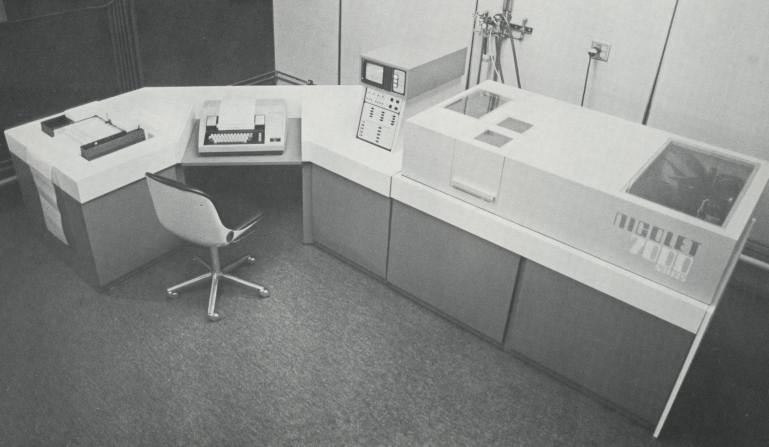
The 7199, introduced in 1977, was Nicolet's first FTIR. The Mini-Cooper sized enclosure
was made of chipcore and blue and pale blue Formica. An 1180 hid in it. It was an
immediate success. Nicolet became, and still is, the world's largest FTIR company.
Here is an odd little historical footnote. The Nicolet NMR division (now called Nicolet
Magnetics) moved to a new industrial park in Fremont, California. As the first occupants,
they could select a street name. They chose Fourier Avenue. A spinoff of Nicolet FTIR,
Mattson Instruments, similarly moved into a new industrial park west of Madison. They
chose Fourier Drive. Both companies are gone, but the name lives on, and many wonder who
Fourier was.
MED-80 Biomedical Data Acquisition System
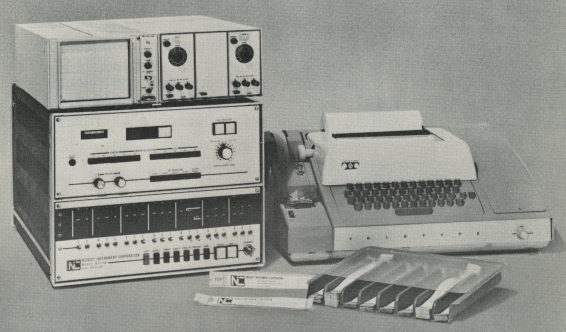
Analytical chemistry was not the only 1080 application. Nicolet formed a biomedical division in 1979. Biomedical division products included a sleep analysis system, a brain analysis system and an evoked response system used to test neonates for hearing and vision problems. None of these used the Nicolet computer. But the MED-80, introduced in 1977, was Nicolet's first biomedical product. It was the brainchild of Don Erickson. He developed the software and the hardware and he wrote the manuals. He was the marketing manager as well as the chief salesman.